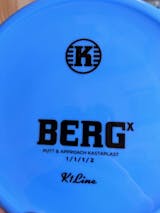
Speed
How fast the disc travels through the air. A low number indicates a slow flight and a high number a fast flight. Generally, a fast disc will travel further but it also depends on the ability of the thrower and the stability of the disc.
Glide
The higher the number the more glide the disc has, it makes for longer shots but with less accuracy.
Turn
The third figure describes the torque resistance of the disc. Where zero is a straight flight, a minus indicates less resistance and a plus more resistance before it turns over. This is commonly known as understable and overstable. The more overstable a disc is the more power and better technique you need in order to make it fly in a straight line, before it starts to fade.
Fade
The last figure is a measure of how the disc will end its flight once air speed and rotation start to decline. When a right handed person throws a backhand, the fade is how much the disc continues to the left at the end. A high number indicates a sharp angle, where a disc with a low figure hit the ground with a less sharp angle down to flat.
The different types of discs
Putter
The first and last choice. The deep rim and heavy appearance make the putter a great disc to start off a disc golf career. The flight stays true to the release angle and the disc comes to rest where it lands, a putter is always the first thought at short range. This disc is also, most likely, the last thing leaving your hand before taking on the next basket. If you control the putter, you control the game.
Mid-range
The disc for smooth tee shots and a faster approach. The wider plate let the mid-range disc sore towards the target with great accuracy, but it requires touch to perform. The over- and understable characteristics of the disc will also come more into play. And when the bag maybe holds one or two type of putters only, you might want a few more mid ranges to fight different conditions.
Fairway driver
When you need to position yourself down the fairway before that easy approach shot or get around the corner with a fierce forehand, the fairway driver is the disc for the job. With the nose down silhouette and sharper edge, the disc cuts through the air for a faster flight and makes it easier to hit your target at a greater distance. It takes more practice but once you get to know your fairway drivers, they will become your best friends.
Distance driver
All you see is the horizon and all you want is a distance driver. When you really need to cover some ground at the local course, reach out for this super fast family of discs. They usually require good technique and a stronger arm in order to unlock their true potential, but they can also be used for sneaky skip shots and get out of jail scrambling. The stability of these discs is a big factor so choose wisely and make sure to read the wind before you pick one from the bag.





